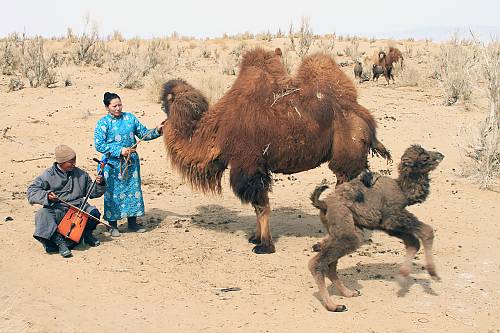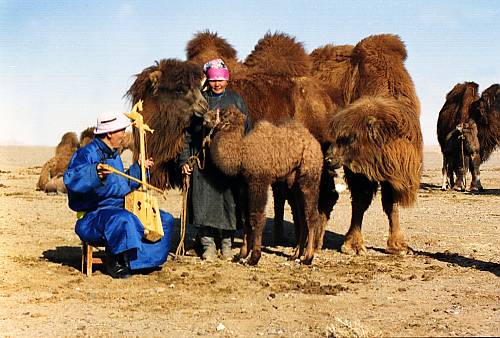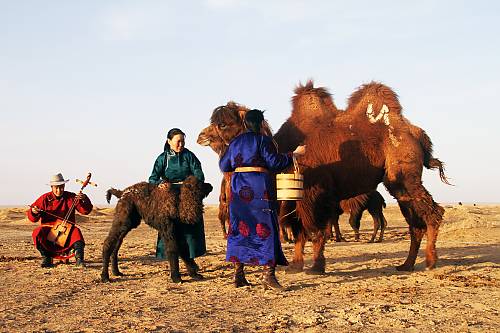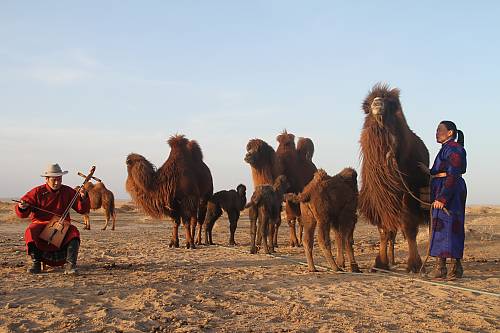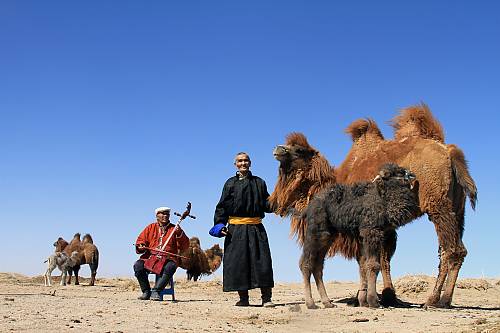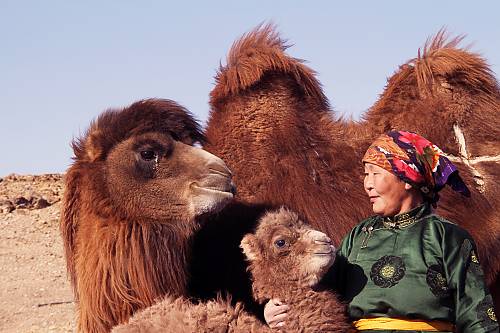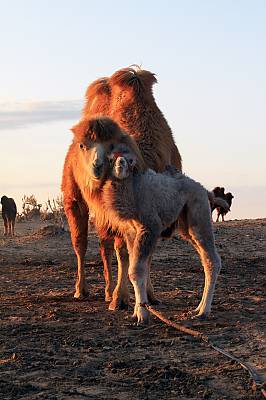Report on the status of an element inscribed on the list of intangible cultural heritage in need of urgent safeguarding
A. Cover sheet
A.1.
State Party
Name of State Party
Mongolia
A.2.
Date of deposit of the instrument of ratification, acceptance, approval or accession
This information is available online.
Date of deposit of the instrument of ratification, acceptance, approval or accession
2005-06-29
A.3.
Element inscribed on the Urgent Safeguarding List that is the subject of this report
Name of element
Coaxing ritual for camels
Inscribed in
2015
Submitting State(s)
Mongolia
A.4.
Reporting period covered by this report
Please indicate the period covered by this report.
A.5.
Other elements inscribed on the Urgent Safeguarding List, if any
Please list all other elements from your country inscribed on the Urgent Safeguarding List, together with the year of inscription; for multinational elements, please indicate the other States concerned.
Other elements inscribed on the Urgent Safeguarding List, if any
Folk long song performance technique of Limbe performances - circular breathing (2011)
Mongol Biyelgee, Mongolian traditional folk dance (2009)
Mongol Tuuli, Mongolian epic (2009)
Mongolian calligraphy (2013)
Mongolian traditional practices of worshipping the sacred sites (2017)
Traditional music of the Tsuur (2009)
A.6.
Executive summary of the report
Please provide an executive summary of the report that will allow general readers to understand the current status of the element, any positive or negative impacts of inscription, the implementation of safeguarding measures during the reporting period and their possible update for the following years.
A.7.
Contact person for correspondence
Provide the name, address and other contact information of the person responsible for correspondence concerning the report.
Title (Ms/Mr, etc.)
Family name
Given name
Institution/position
Address
Telephone number
E-mail address
Other relevant information
B. Status of element inscribed on the Urgent Safeguarding List
Refer to the nomination file or to previous reports, if any, as the basis for reporting on the current status of the element, and report only on relevant changes since the date of inscription on the List or since the previous report. Nomination files, specific timetables and earlier reports, if any, are available at https://ich.unesco.org or from the Secretariat, upon request.
The State Party shall pay special attention to the role of gender and shall endeavour to ensure the widest possible participation of the communities, groups and, where applicable, individuals concerned as well as relevant non-governmental organizations during the process of preparing this report, and is asked to describe how it has done so in point D below.
B.1.
Social and cultural functions
Please explain the social and cultural functions and meanings of the element today, within and for its community, the characteristics of the bearers and practitioners, and any specific roles or categories of persons with special responsibilities towards the element, among others. Attention should be given to any relevant changes related to inscription criterion U.1 (‘the element constitutes intangible cultural heritage as defined in Article 2 of the Convention’).
Social and cultural functions
Mongolian herdsmen perform a ritual called the Coaxing ritual to strengthen the bond between mother animals and their newborns. It involves using special words and melodies to encourage the mother to accept her baby and is particularly important for camels. According to article 2.2 of the Convention for the Safeguarding of Intangible Cultural Heritage, this heritage element belongs to the domain of “oral traditions and expressions, including language as a vehicle of the intangible cultural heritage”, “Social practices, rituals and festive events” and domain “performing arts” and domain “knowledge and practices concerning nature and the universe”.
The coaxing ritual unique form of intangible cultural heritage, because it is the way of adopting a newborn orphan and rejecting a baby by its mother. It is the ritual of singing and playing musical instruments with psychological communication of herdsman and animal through consonant melody for adopting baby camel.
An inscription of this heritage element on the List of Intangible Cultural Heritage in Need of Urgent Safeguarding, UNESCO has played a significant social and cultural role not only to practitioners and herders but also for all Mongols to be proud of their nomadic lifestyle and understand that traditional methods and cultural heritage are an integral part of their life and importance to transmission to youth.
While elsewhere spring is a pleasant season for peasants, it isn’t convenient for Mongolian herdsmen. Every 2 years, mother camel gives birth to their young in a harsh and dusty spring, so there is a big risk of losing a mother or a baby animal. Therefore, tying the mother camel and orphaned baby camel using this ritual practice and knowledge is one of the factors that keep the camel population in our country from declining.
The most important role played in the Coaxing ritual is experienced by herders singers women and musicians, who will have psychological contact with animals, through the lyric melody. While the children are learning from the older generation how to perform the ritual, they will have information and knowledge on the traditional behavior of nomads to love and respect elders and to protect the natural environment. As one of the unique relationships of humans to animals and the environment, the Coaxing ritual is very suitable for the sustainable development of Mongolia, because of a unit of cultural bearers and practitioners, their communities, and groups to safeguard the ritual.
Camel herders, communities of cultural bearers and practitioners, and groups of elders and supporters are the main actors in the continuity of the Coaxing ritual as a useful practice of camel raising and an unforgettable tradition of human/ animal relationship of nomads in the future.
B.2.
Assessment of its viability and current risks
Please describe the current level of viability of the element, particularly the frequency and extent of its practice, the strength of traditional modes of transmission, the demographics of practitioners and audiences and its sustainability. Please also identify and describe the threats, if any, to the element's continued transmission and enactment and describe the severity and immediacy of such threats, giving particular attention to any strengthening or weakening of the element’s viability subsequent to inscription.
Assessment of its viability and current risks
Today, this element is being practiced in Dundgovi, Umnugovi, Dornogovi, Govisumber, Gobi-Altai, Bayankhongor, Uvs, and Khovd, Dornod, Tuv, Uvurkhankgai, and Khuvsgul provinces.
As of 2022, the Govisumber province has a total of 1007 camels and coaxing ritual is being practiced in this province. Herders herd camels for four seasons of the year and get benefits from camels for four seasons.
Dundgovi province has a total of 41138 camels and herders in the south of the territory are herding camels along with pasture areas. Dundgovi province has a total of 15 soums and only 3 practitioners identified and inventoried in 3 soums and the viability of this element is very weak in this province.
Tov province has a total of 3975 camels and there are a total of 7 practitioners identified and inventoried 5 soums.
Uvs province has a total of 27234 camels and only 3 practitioners inventoried at the Zavkhan soum of Uvs province, traditional knowledge and practice associated with herding camel is on the edge of disappearance and it is important to increase the number of practitioners in this province through apprenticeship training.
Khuvsgul province has a total of 2507 camels, and after the inscription of the element on the USL, the number of camel herders increased. With the increase in camel number, revitalization of camel load and nomad migration practices occurred.
Bayankhongor province has a total of 45529 camels 17457 of them are female camels and several camels are increasing year by year. Elder practitioner Sh.Tseveen was included in the “National List of Intangible Cultural Heritage Practitioners” in 2019 because she practiced coaxing ritual for camels. In Bayanlig soum of Bayankhongor province, there is a total of 10 practitioners inventoried.
Ovorkhangai province has a total of 19,300 camels, only practitioners D.Dorj and his family members are representing this element in their province.
Khovd province has a total of 29557 camels but no practitioners inventoried.
Omnogovi province has a total of 164766 camels, but only 14 practitioners are inventoried.
Although the viability of the element “Coaxing ritual for camels” is enhanced, the number of herders is being decreased, and the following risks still exists. As for including:
1. The number of herders who herd camel is less
2. Camel herding practice is uncommon or unidentified in mountainous areas
3. Camels are being used for domestic uses for loading and riding
4. The environment where to herd and increase camel is less.
These statistics from the local community show that the environment for practicing this type of heritage element is shrinking more and more. The number of herders in rural areas is decreasing due to the sharp increase in population migration from rural to urban areas. Due to this, transmission of knowledge and practices associated with coaxing ritual is being lost and negative impacts occurred in the sustainable development of traditional pastoralism.
As well as, due to the mining development in Gobi area young camel herders are willing to drive lorries to get more income.
B.3.
Implementation of safeguarding measures
Please report on the safeguarding measures described in the nomination file, and previous report, if any. Describe how they have been implemented and how they have substantially contributed to the safeguarding of the element during the reporting period, taking note of external or internal constraints such as limited resources. Include, in particular, information on the measures taken to ensure the viability of the element by enabling the community to continue to practise and transmit it. Include the following detailed information concerning the implementation of the set of safeguarding measures or safeguarding plan:
B.3.a.
Objectives and results
Indicate what primary objective(s) were addressed and what concrete results were attained during the reporting period.
Objectives and results
Practitioners of Omnogovi, Dundgovi, Dornogovi province attended the “Nomadic Mongolia-2022” intangible cultural heritage festival. In addition, the Natural History Museum organized activities to promote the element during this festival.
Due to the COVID-19 pandemic and natural and economic circumstances, the formal and informal training was canceled, even though, online podcasts for raising awareness organized and experts from relevant departments of the relevant ministries delivered presentations.
Activities planned to be implemented within the objective to support camel households to have horse fiddle, flute, and Jew harp and develop family members’ skills of coaxing and playing on the musical instruments could not fulfilled due to the Covid-19 pandemic and natural and economic circumstances.
In 2020, the Omongovi province gave a “Certificate of Honour” to practitioners O.Batjargal, Kh.Khuukhenduu for giving a contribution to the safeguarding of this heritage element. In 2022, the Bayankhongor province gave awards “Most Talented Practitioner” to practitioners Danzan and Tseven for practicing the element in a high level of skills and practices.
In addition, the Ministry of Food, Agriculture and Light Industry is giving rewards annually to herders who are selected among others, by following criteria such as herding their livestock by the traditional way of herding, giving a special contribution to the increase of camel numbers by their administration units.
Not only Gobi region, but also in the western region including Khovd, Uvs, and Govi-Altai provinces, safeguarding measures such as revitalization, promotion, and training workshops organized for enhancing the viability of the “Coaxing ritual for camels”. In addition, aiming to expand the distribution of this heritage element in other areas, provincial, regional, and national “Consultative meetings for camel herders” have been organized in Khovd, Bayankhongor, and Omnogovi provinces.
Govi-Altai province has organized training for cultural heritage specialists on the theme “Safeguarding of intangible cultural heritage” and carried out research and documentation. Dundgovi province has made documentation of the “Coaxing ritual for camels” from a young herder family. Govisumber Province identified 4 practitioners and inventoried and documented them. Ovorkhangai province carried out a preliminary survey on the identification of practitioners and made inventorying and documentation for practitioners in Togrog soum.
In 2020, the National Center for Cultural Heritage organized an online training workshop for specialists and cultural center directors in the Gobi region on the theme “Improving the inventorying and documentation of intangible cultural heritage” and the documentation methodology and technique given to the aforementioned specialists in the case element.
In 2022, training was organized for the director of 14 cultural centers of Omnogovi province on the theme “Coaxing ritual for camels” and a documentary film was shown and methodology given to promote this heritage element. As a result of this work, cultural heritage specialists in the local area have experience in inventorying and documenting this heritage element.
“Camel festivals” are being supported by the Ministry of Culture, the Ministry of Environment and Tourism, the Ministry of Food, Agriculture and Light Industry, and the Local Governing Administration.
In 2023, “Camel Culture Cabinet” was founded in Dundgovi Province museum.
B.3.b.
Safeguarding activities
List the key activities that were carried out during this reporting period in order to achieve these expected results. Please describe the activities in detail and note their effectiveness or any problems encountered in implementing them.
Safeguarding activities
“Camel is sky animal” educational program and hand drawing competition organized in Dundgovi province.
Provincial, regional, and national festival called “Camel Festival” is annually organized in Dundgovi, Omnogovi, Govi-Altai, Bayankhongor, Khovsgol province. During these festivals, several competitions for different ages of camels, presentations of coaxing rituals, attractive couples with beautiful camels, camel parades, local camel wool products, handicraft exhibitions, and dairy product exhibitions are organized and herders attend.
A national consultative meeting “Camel is Sky Animal 2020” was organized in Bogd soum of Bayankhongor province and during this consultative meeting, the “Camel Festival” was also organized. Practitioners and representatives of government and non-governmental organizations attended the meeting from Bayankhongor, Omnogovi, Ovorkhangai, Govi-Altai, and Khovd provinces.
The local administration of the Dundgovi province has paid much effort to the safeguarding of this heritage element. For instance, aiming to increase the number of camels, Dundgovi province has allocated incentives to those herders who herd camels, gave support to the organization of camel festivals, and organized multifaceted activities in the territory of the province. As a result of these activities, the transmission of this heritage element was sustained, and apprenticeship training for coaxing ritual, apprenticeship training of folk long song and horse head fiddle conducted, and camel events and festivals were organized regularly.
A consultative meeting of camel herders in Khovd province was organized in April of 2022, in cooperation with the Citizen’s Representative’s Khural of Khovd Province, Local Governing Administration of Khovd Province, Food and Agricultural Agency, Citizen’s Representative’s Khural of Mankhan soum, Local Governing Administration of Mankhan soum. In this consultative meeting, practitioners of this heritage element and camel herding practices attended from 17 soums of Khovd province and had discussions on troubles faced in the herding of camels, advantages, and possibilities associated with camel herding.
- In December 2022, a national consultative meeting of camel herders and camel racing was organized in Omnogobi province. A total of 112 representatives from government, non-governmental organizations, research institutes, and camel herders from Omnogovi, Dundgovi, Dornogovi, Bayankhongor, and Ovorkhangai provinces attended this consultative meeting and shared experiences on an increasing number of camels and benefits from camels.
Good practices to allocate monetary incentives for raising baby camels developed in Omnogovi, Dundgovi, Dornogovi, and Khovd provinces.
The local museum of Ondorshil soum of Dundgovi province established a new cabinet for camels in 2023 to promote the culture associated with camels and within the educational program, the coaxing ritual for camels is being taught for children.
B.3.c.
Participation of communities, groups or individuals in the safeguarding activities
Describe how communities, groups or, if appropriate, individuals as well as relevant non-governmental organizations have effectively participated, including in terms of gender roles, in the safeguarding measures. Describe the role of the implementing organization or body (name, background, etc.) and the human resources that were available for implementing safeguarding activities.
Participation of communities, groups or individuals in the safeguarding activities
In Article 34 of the Protection Law on the Cultural Heritage, the rights and obligations of the practitioner have been first time defined, such as in the para 34.1.1. it states that “to receive financial support to protect, transmit and recreate the intangible cultural heritage, under the necessary circumstances", on para 34.2 “to teach students and transmit intangible cultural heritage to the next generations; to disseminate and promote intangible cultural heritage; to provide assistance to record information and conduct registration of intangible cultural heritage”.
The herders themselves are reviving and transmitting this heritage traditions related to mother and baby camel, while actively promoting this heritage to the public, passing it on to their children, and conducting apprenticeships.
For instance, 12 practitioners in 9 families who are practicing this heritage element of 5 generations of Daanyam in Mandal-Ovoo soum of Omnogovi province, elder practitioner Dugerkhuu and her children, 6 families including children of S.Tsenddoo herder in Khanbogd soum, P.Batsaikhan and his family in Tsogt-Ovoo soum, horse head fiddler B.Tuvden and his family in Delgerkhangai soum of Dundgovi province, camel herding community in Bayanlig soum of Bayankhongor province including practitioners Danzan, Tseveen, Dagdulamm Bayasgalan, practitioners B.Tomormonkh, N.Enkhbaatar, L.Otgonbaatar, B.Yeroolt in Govi-Sumber province, practitioner Dorj in Ovorkhangai province played an active role in the safeguarding of this heritage element during this reporting period.
Media organizations have increased their desire and initiative to cooperate with the practitioners, community, governmental and non-governmental organizations in publicizing and popularizing activities. For instance: The state regional competition “Camel is Sky Animal” organized in 2020 and during this competition, a state consultative meeting was organized and representatives of 27 soums in 5 provinces attended.
Uvs province organizes the “Ten Thousand Camel’s Festival” in every year with the cooperation of the Local Governing administration of Zavkhan soum, the Cultural Center of Zavkhan soum, and practitioners and local people.
Over 1000 persons attended in the “Camel Festival” organized in Khovsgol province.
B.3.d.
Timetable
Indicate in a timetable when each activity was implemented.
Timetable
Although, the 5 years national program “Safeguarding of Intangible Cultural Heritage” was approved by the 68th Resolution of the Government in 2019, due to the impact of the Covid-19 pandemic Mongolia has moved to a high level of disaster preparedness, and any cultural activities were cancelled between 2020-2022. In order not to disrupt the safeguarding activities for this heritage element in that pandemic situation, activities are organized online.
- To safeguard traditional knowledge and practice associated with coaxing ritual, and to strengthen the viability of 2019-2023
- To promote and reward practitioners of this heritage element 2019-2023
- To organize a regional meeting for camel herders and practitioners of this heritage element 2019-2023
- To improve the registration and information database, and inventorying and documentation 2019-2023
- To conduct capacity-building training and seminars for ICH specialists and practitioners of this heritage element 2019-2023
- To create sustainable management and strengthen multifaceted cooperation 2019-2023
B.3.e.
Budget expenditures
Provide the detailed amounts of the funds used for the implementation of each activity (if possible, in US dollars), identifying the funding source for each (governmental sources, in-kind community inputs, etc.).
Budget
The Law on the Protection of Cultural Heritage was amended in 2014 by the State Great Khural of Mongolia and article 41 of the law states that "funding of cultural heritage shall come from the state budget, local budget, funds provided by Mongolian and foreign citizens, international organizations, legal entities, donations, assistance, and other sources” on the article 14, para 14.1.10. it stated that "141.1.10.to reflect in the state budget per annum the measures to protect and restore authenticity and integrity of the immovable historical and cultural memorials registered in the preliminary list of World Heritage and the World Heritage List, and to protect and strengthen the viability of intangible cultural heritage registered in UNESCO's Representative List and the List of Intangible Cultural Heritage in Need of Urgent Safeguarding, for protection, and implement them”. In addition, on the article 15 “Citizens' Representatives Khurals of aimags, soums, the Capital city, and districts shall have the following common powers concerning the protection of cultural heritage”, para 15.1.1. it has stated that “to approve medium term policy and main directives to protect cultural heritage within their territory”, on the article 16 “The Governors of aimags and the Capital city shall have the following powers concerning the protection of cultural heritage”, on the para 16.1.12. it has stated that “to identify bearers of intangible cultural heritage, as well as provide publicity and assistance and organize activities of transmission”. Indeed, these articles enable possibilities to spend local budget for safeguarding intangible cultural heritage.
Bayankhongor province:
- Within the reporting period, a total of 15.900.000 MNT was spent on the organization of the camel festival.
- According to article 4.1.4 of the contract made between the Minister of Culture, Mongolia, and Local Governor of Bayankhongor province in 2023, and article 39.2 of the Law on the Protection of Cultural Heritage, the element “Coaxing ritual for camels” presented in the “Nomads” world cultural festival and total of 40.000.000 MNT has spent.
Uvs province:
- For supporting camel herders in Uvs province, a total of 8.000.000 MNT was spent in 2023.
Khovsgol province:
- For promoting the heritage element for the public, a total of 20.000.000 MNT has been spent.
B.3.f.
Overall effectiveness of the safeguarding activities
Provide an overall assessment of the effectiveness of the activities undertaken to achieve the expected results and of the efficiency of the use of funds for implementing the activities. Please indicate how the activities contributed to achieving the results and whether other activities could have contributed better to achieving the same results. Also indicate whether the same results could have been achieved with less funding, whether the human resources available were appropriate and whether communities, groups and individuals could have been better involved.
Overall effectiveness of the safeguarding activities
- Certain progress has been made in the creation of a normal and stable system for revitalizing, safeguarding, developing, training, studying, and promoting the ICH.
- Increasing the initiative and participation of practitioners, individuals, communities, groups, and non-governmental organizations in the activities associated with the safeguarding, promotion, and transmission of intangible cultural heritage increased in cooperation with the state central organization responsible for culture, local, and cultural organizations.
- The willingness and initiative of media organizations to cooperate with the practitioners, communities, and governmental and non-governmental organizations in promoting and disseminating intangible cultural heritage to the public has increased.
C. Update of the safeguarding measures
C.1.
Updated safeguarding plan
Please provide an update of the safeguarding plan included in the nomination file or in the previous report. In particular provide detailed information as follows:
- a. What primary objective(s) will be addressed and what concrete results will be expected?
- b. What are the key activities to be carried out in order to achieve these expected results? Describe the activities in detail and in their best sequence, addressing their feasibility.
- c. How will the State(s) Party(ies) concerned support the implementation of the updated safeguarding plan?
Updated safeguarding plan
Within the reporting period, although there were several activities organized in association with the culture associated with camels, most of them were festivals and competitions and indeed there were fewer activities organized for disseminating the knowledge and practices associated with the element “Coaxing ritual for camels”. The updated safeguarding plan has elaborated based on experiences faced by local heritage specialists who are working to safeguard and strengthen the viability of this heritage element and also based on comments raised by practitioners of this heritage element.
Following comments raised by cultural heritage workers in the local area and also by practitioners of this heritage element:
- To increase the local support for practitioners of this heritage element
- To implement a special program for safeguarding of this heritage element
- To conduct apprenticeship training in the cultural spaces where the heritage is being practiced
- To transmit the knowledge and practice associated with camel herding to young herders
- To increase the benefits of the camel and promote it to the public
- To expand the organization of the camel festival and involve herders from other soums and areas to the festivals
- To increase the budget of local governing administration for safeguarding this heritage element and support by policy
- To implement the project in soums and provinces of the gobi region where the coaxing ritual is recognized and to inventory and document practitioners of this heritage element, to elaborate handout for apprenticeship training and organize apprenticeship training, to make content and broadcast it through TV and social media for strengthening the viability of this heritage element.
- To ensure the stability of the job of a cultural heritage specialist in the local area. The instability of the local cultural heritage specialist brings difficulties in the identification and inventorying of practitioners of this heritage element.
The safeguarding plan has been updated in line with Mongolia's Long-term development policy document VISION - 2050, the Action program of the Government of Mongolia, the Main Directions for the Development of Mongolia in 2021-2025, the Main directions for Improving the Legislation of Mongolia until 2024, the Ministry of Culture's Strategic Plan 2021- 2024:
The following activities are planned to be carried out in cooperation with governmental and non-governmental organizations, inheritors, researchers, research institutes, local governments, and communities to safeguard the element and strengthen its viability. It includes:
Objectives:
- Conduct field research for inventorying and documenting the coaxing ritual for camels,
- Develop and approve the necessary legal documents related to the increase of the population of camel and to coordinate them with the current sectorial documents
- Raise awareness,
- Organize apprenticeship training for young herders of camel,
- Develop cultural production, products, and services,
- Organize national conferences for camel herders.
C.2.
Timetable for future actitivies
Provide a timetable for the updated safeguarding plan (within a time-frame of approximately four years).
00310,00311,00312,00543,00871,00873
Timetable
To ensure the viability of this element, the following safeguarding measures are to be undertaken with the different stakeholders. For instance:
Field research in 2024-2025:
- Conduct field research in 10 provinces in cooperation with the MOC, the Ministry of Food, Agriculture and Light Industry, the NCCH, Local Governing Administrations, the Culture and Art Agencies in provinces, the Food and Agricultural agencies in provinces, and practitioners for inventorying and documenting.
- Create a database in cooperation with the MOC, Ministry of Food, Agriculture and Light Industry, the National Center for Cultural Heritage, ICT Company,
Develop and approve the necessary legal documents in relation to increase of camels and combine them with the current sectorial documents, in 2024-2027
• Develop a specific safeguarding plan with the Ministry of Culture and the Provincial Government Office for the coaxing ritual for baby camels in the related areas
• In cooperation with the MOC, the Ministry of Food, Agriculture and Light Industry, and the Ministry of Finance approve regulations for promoting good herdsmen, best practices, and traditional knowledge, as well as providing incentives for the number of herders.
• Develop and approve a program to support cultural and domestic tourism based on "Camel culture: Coaxing ritual for baby camel" in cooperation with the MOC and the Ministry of Environment and Tourism
• In cooperation with the MOC and the Ministry of Health, to increase access to the benefits of camel's dairy products, to promote the importance, and to organize influence activities for their widespread use.
• In cooperation with the MOC and the Ministry of Education and Science to include cultural heritage education in the curriculum of primary and secondary schools
• In cooperation with the Government implementing agency Culture, and Arts Authority, to create monetary incentives to select and celebrate the best practices of Safeguarding ICH in need of urgent safeguarding, to approve procedures and sustain.
Raise public awareness in 2024-2027
• Publish a simplified cognitive photo catalog
• Electronic content based on VR technology for educational programs (museum, local study hall, non-formal educational program)
• Develop a mobile app that introduces camel culture to young people
• Produce documentary film and video content
• Elaborate the handouts (for children, for young herders) and make them available to the public
Organize apprenticeship training for young herders in 2024-2027
• Organize tutor training courses at each center of 10 provinces for herders.
• Organize training for young camel herders in the local area.
• Order and make traditional musical tools for training (such as fiddles and fiddles).
Develop cultural production, products, and services in 2025-2026
• Organize step-by-step activities to introduce the benefits of camels as creative cultural production and develop products and services in cooperation with the Department of Intellectual Property, the Chamber of Commerce and Industry, and the Department of Small and Medium Enterprises
Organize national conferences for camel herders in 2026-2027
• To organize a conference to exchange experiences of camel herders in Gobi, Khangai, and Western regions
C.3.
Budget for future activities
Provide the estimates of the funds required for implementing the updated safeguarding plan (if possible, in US dollars), identifying any available resources (governmental sources, in-kind community inputs, etc.).
Budget
For the next cycle of the reporting period (between 2024 and 2027) the Government of Mongolia has decided to request international assistance from the Intangible Cultural Heritage Fund of UNESCO for safeguarding and strengthening the viability of this heritage element and has drafted the project proposal on form ICH-04 (it will be sent to Secretariat of 2003 Convention by email).
The following activities are to be undertaken within this project:
1 Conduct field research for inventorying and documenting the coaxing ritual for camels
2 Develop and approve the necessary legal documents related to the increase of the population of camel and coordinate them with the current sectorial documents
3 Raise awareness
4 Organize apprenticeship training for young herders of camel -
5 Develop cultural production, products, and services
6 Organize national conferences for camel herders
7 Other
State party contribution to the project is 40,000 $
The requested amount from the ICH fund is 95,000 $
C.4.
Community participation
Please describe how communities, groups and individuals, as well as relevant non-governmental organizations have been involved, including in terms of gender roles, in updating the safeguarding plan, and how they will be involved in its implementation.
00147
Community participation
This updated action plan has been elaborated by the working group including representatives of the Ministry of Culture, the Government's implementing agency Authority of Culture and Arts, the National Center for Cultural Heritage, Local Culture and Arts Agencies, and practitioners of Govi-Altai, Bayankhongor, Ovorkhangai, Dundgovi, Omnogovi, Dornogovi, Govisumber, Tov, Uvs and Khovsgol provinces organized by the Order A/353 of the Minister of Culture of Mongolia for writing the periodic reporting. Based on the problems faced in the safeguarding of this heritage element, and comments of practitioners, and local cultural heritage workers who are working to safeguard and strengthen the viability of this heritage element, this updated plan has been formulated in line with Mongolia's Long-term development policy document VISION - 2050, the Action program of the Government of Mongolia, the Main Directions for the Development of Mongolia in 2021-2025, the Main directions for Improving the Legislation of Mongolia until 2024, the Ministry of Culture's Strategic Plan 2021- 2024.
The Ministry of Culture will create an appropriate legal environment, formulate policies, allocate and monitor the necessary budgets into the state budget, and provide guidance and methodology for the implementation of national activities by the Culture and Arts Authority. The National Center for Cultural Heritage will organize multifaceted safeguarding activities, such as organizing national competitions, scientific conferences among practitioners and raising public awareness campaigns, creating series, documentaries, books, CDs, and intensifying research, and organizing inventories and inspections.
The activities included in the plan shall be organized in consultation and cooperation with specific, other, and non-governmental organizations, researchers, and the public according to the Law on the Protection of Cultural Heritage.
Practitioners are obliged to transmit, promote, and inherit at the national and international levels and are necessary to take part in other safeguarding plans actively.
C.5.
Institutional context
Please report on the institutional context for the local management and safeguarding of the element inscribed on the Urgent Safeguarding List, including:
- a. the competent body(ies) involved in its management and/or safeguarding;
- b. the organization(s) of the community or group concerned with the element and its safeguarding.
2005-06-29
Institutional context
a). Ministry of Culture, Mongolia
Address: Ministry of Culture of Mongolia, Sukhbaatar district, 7th sub-district, Ulaanbaatar, Mongolia.
Byambasuren DAVAATSEREN
Director of Cultural Heritage Department
Phone: + 976- 51-265609
Email: davaatseren@moc.gov.mn
b). National Center for Cultural Heritage
Family name: Arslan
Given name: Saruul
Title: Head of Registration and Information Department, National Center for Cultural Heritage
E-mail: saku99030405@gmail.com
Phone:+976 99030405
D. Participation of communities in preparing this report
Describe the measures taken to ensure the widest possible participation of the communities, groups and, where applicable, individuals concerned as well as relevant non-governmental organizations during the process of preparing this report.
Participation of communities in preparing this report
Based on Article 24.2 of the Law on the Government of Mongolia and Article 29 of the 2003 UNESCO Convention on the Safeguarding Intangible Cultural Heritage, a working group was established to prepare a periodic report in accordance with Order A/353 of the Minister of Culture of Mongolia. Representatives of the Ministry of Culture, the Government's implementing agency Authority Culture and Arts, the National Center for Cultural Heritage, Local Culture and Arts Agencies, and practitioners of Govi-Altai, Bayankhongor, Ovorkhangai, Dundgovi, Omnogovi, Dornogovi, Govisumber, Tov, Uvs and Khovsgol provinces participated in the report writing.
E. Signature on behalf of the State Party
The report should be signed by an official empowered to do so on behalf of the State, and should include his or her name, title and the date of submission.
Name
MR. BATBAYAR Munkhuu
Title
Deputy Minister of Culture, Mongolia
Date
14-12-2023
Signature
BATBAYAR Munkhuu
Upload signed version in PDF

